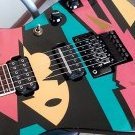-
Posts
38 -
Joined
-
Last visited
Rachmaninoff's Achievements
-

What Helix Software Utilities Exist and Where are they?
Rachmaninoff replied to Gillespie1983's topic in Helix
Well, reverse engineering the USB traffic is definitely possible... but that would require a lot of work, plus the risk of damaging your unit. -
Oh, that forum where the average age is 60 years old, and the average mental age is 14 years old? No, thanks.
-

How to Craft Warmer More Tube Sounding/Feeling Helix Patches
Rachmaninoff replied to IMMikeMurphy's topic in Helix/HX
As said by @brue58ski, Jason Sadites has many videos on Helix tweakings, where he explains how you should deal with the parameters in great detail. Other than that, my personal approach is start simple. Choose a head and a cab first, then a pedal do push the signal before the head. This is the core of your tone: if you make these 3 blocks sound good, everything else is minor. Just like working with actual, analog gear. -

So this might be silly but... (mic'ing amp with helix)
Rachmaninoff replied to RicardoGrilli's topic in Helix
Not silly... but most Helix effects were designed with a raw guitar signal in mind. You'll probably use very few of them. Nonetheless, if you don't own an actual audio interface, yes, Helix is an audio interface with excellent A/D/A converters, and you can use it. Of course, an actual audio interface would be a lot more practical to use, in particular to feed active monitors. Personally, I use a Volt 2 for such purpose, but the market has several low budget models which also sound great. -

I got Helix to work as an audio interface in Linux!
Rachmaninoff replied to doughywilson's topic in Helix
Win10 is rock solid, too stable to be dismissed... I bet it will still be heavily used way beyond planned, just like Win7 did. I use Win10 myself, and I don't plan to migrate to Win11 at all. -
A memory card would expand memory... not processing.
-
My last serious band ended during COVID years, and since then I've not really been playing. I own a Helix LT, and the last firmware update I installed was the one with the Poly Capo, which I loved and used extensively to play songs in different tunings. Fast foward to last week. I was invited to join a new band, and I noticed there was an update for the Helix. Then I installed it. I read about the changes, and there was a new amp, a few other minor things, and that's it. Okay, nothing that would affect me, but no problem. Then yesterday I found something about a cab update, which was a previous update which I missed. After googling it, I found a different cabinet screen, which I didn't even know it existed. Plugging my Helix, yes, this new screen was there. All my patches have been moved to "legacy cabs". Okay. Then I decided try the new ones, and... HOLY SH*T. HOLY SH*T. I'm still in awe of the tones I'm getting out of this black box. I didn't even had to tweak much, every setting sounds incredible. And being a compulsive tweaker myself, I can't stop experimenting with the new cab settings, different combinations and tones. It just sounds so good. So good. Every amp sounds open and alive now, in particular the Cali IV, which I use for high gain stuff. I just wanted to share this moment, when the Helix brought me so much joy. Thank you.
-
This is the root cause for so many things these days...
-
I own the Helix LT. You can plug your amp using the 4-cable method, and it essentially becomes another block inside the Helix FX chain. The DSP power of the LT is very useful once you start experimenting all those effects and possibilities. Just for the record: these days I don't use my amp on the stage anymore. My Helix LT (loaded with some impulse responses) does the job. Not carrying a heavy amp is liberating!
-
Hi, Brazilian here. The Helix is rather expensive indeed. I bough a new LT for R$ 9600, but the prices can be much higher. I come from an HD500X (and a POD X3 Live before that), so the size wasn't much of an issue to me. It's a big and heavy unit, though. I also use the Helix LT as an audio device (at home) and for playing live, but straight to the mixing desk, not with a real amp. It requires time and dedication, but you can get pretty much any tone you want. Honestly, the oversampling will make no difference to your ears. As for the analog pedalboard, I got rid of mine several years ago. Using a single digital unit for everything is way easier, and I strongly suggest this approach. The Helix converters are as good as they can be.
-
Rachmaninoff changed their profile photo
-
That's one of the biggest differences, IMHO. Having two DSPs in the Helix (and LT) makes a world of difference. These days I'm using the Poly Capo extensively, and it eats a lot of DSP power, something that makes it really hard to apply without the two DSPs.
-
I'm deciding between the Helix and the Helix LT, and now I have this question. These are my current needs: the XLR and 1/4" to be always at full volume – ie. not being adjusted by the volume knob; the headphones to be adjusted by the volume knob. Question: Is it possible to be done on the Helix LT? Page 65 of the manual says: ... but there is no mention if the headphone volume will still be controlled by the volume knob.
-

HD500X: edit amps settings without using the big knobs?
Rachmaninoff replied to Rachmaninoff's topic in POD HD
Such an useful forum we have here.





